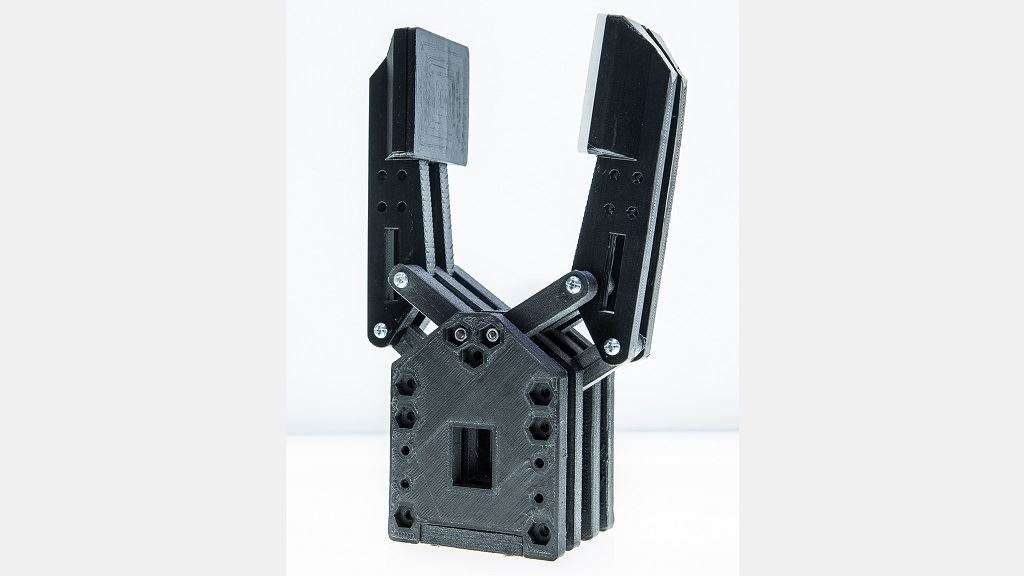![Robotic soft-touch gripper made with BASF’s highly flexible Ultrafuse filaments using Essentium’s HSE technology [Image: BASF 3D Printing Solutions]](https://fabbaloo.com/wp-content/uploads/2020/05/roboticsofttouchgripper_img_5eb0916110eb2.jpg)
3D printing is a dynamic, growing industry. Materials giant BASF knows this well, having spent years strategizing its entry into and participation in additive manufacturing.
In 2017 the company introduced its focused subsidiary, BASF 3D Printing Solutions (B3DPS). It is through this business arm that the global chemicals giant is working with partners and customers in, appropriately, solutions for 3D printing.
One important aspect of B3DPS is that it is a wholly-owned subsidiary of one of the world’s largest material companies. BASF, to put it plainly, is a Big Deal. Such massive entities do not tend to undertake new business ventures lightly; many regard these operations as a startup within the larger company.
Part of BASF’s strategy in entering the 3D printing industry has been to partner with other participants. Among these collaborative partners is Essentium. The Texan company is behind interesting innovations in materials and high-speed extrusion-based 3D printing — and is currently beleaguered by a high-profile lawsuit.
When I spoke recently with Essentium CEO Blake Teipel, PhD, he offered a look into his vision for innovation in 3D printing, particularly the critical importance of allowing customers to innovate.
He also touched on the importance of due diligence in business deals, noting that BASF in particular was clearly among those who take the time to examine strategies before moving forward — and that partnering with Essentium remains a focus for BASF including during these trying times.
To follow up on that conversation and gain more perspective into what BASF is planning, I touched base with Volker Hammes, Managing Director BASF New Business GmbH and Vice President, Head of Business Build-up 3D Printing.
Customer Innovation
The companies behind the industry are of course necessary for 3D printing to advance. But it’s really the customers who will be using the tools developed for the real-world work that additive manufacturing can produce.
Hammes speaks to the importance of customer innovation in 3D printing:
“For decades customer innovation exploiting the full potential of additive manufacturing technologies has been hampered by i) strong IP positions of few players hindering others to innovate, ii) closed business models putting industrial AM out of reach for economic reasons, iii) limited use of collaborating and partnering to bundle capabilities and faster advance in solution development. Moreover, customer needs were often not being addressed by using the proven and successful innovation process of first analyzing the use case requirements in depth, then selecting the optimal material of choice, then selecting a suitable manufacturing technology, then designing for part performance considering both material and processing specifics, and finally testing and establishing this whole set-up on the manufacturing floor. Instead, whoever had a solution on hand tried to convince the customer to realize the application with his own proprietary technology hereby often compromising on performance and solution economics.
BASF aims at transforming 3D-printing from prototyping into industrial AM based on making more, better, and cheaper ready-to-print material formulations available, partnering with innovative 3D-P equipment makers and pioneering service bureaus or OEMs as well as developing new demanding senior use case applications with the help of BASF’s deep application knowhow accumulated over decades of innovating for customers, and advanced design & simulation tools. All of this is done by offering the optimal 3D-P solution selected from any of the leading 3D-P technologies for any given case.”
The Lawsuit Against Essentium
This is of course a touchy subject.
Not only because it’s delicate and remains publicly in a bit of a he-said-she-said predicament where the full truth is not known, nor has a jury made any major decisions, but because of the very nature of ongoing legal action. Comment on current lawsuits is difficult, and as a rule involved parties — and any parties involved directly with either of those parties — will leave formal reactions for the courtroom.
Hammes’ comments here indicate, though, that BASF is standing by its partner and the vision that brought the companies together:
“Generally, we do not comment on business and legal affairs of 3rd parties.
From all we know, up to now the claims by Jabil are of a rather general legal nature and the claimed wrongdoing is yet to be specified. From all our previous dealings with Essentium we have no reasons to doubt the integrity of the company, its management or its employees. We will continue unwaveringly with our joint efforts to transform the world of manufacturing.”
BASF’s Work with Essentium
What Hammes can speak to, though, is the work that has been and continues to be done.
Essentium and BASF have shown a strong and sustained partnership, and one that both parties have consistently pointed to as of strategic importance in our conversations through the last couple of years.
Of this ongoing work, Hammes comments:
“Essentium is one of our earliest co-innovation partners. Our collaboration started with addressing unmet customer needs by jointly developing new filaments made from engineering plastics hereby focusing on enhanced material properties, processing behavior, and especially solving the problem of anisotropy, i.e. improving z-strength to the same level of horizontal directions. Shortly after Essentium embarked on the journey to develop their own hse printer platform, BASF decided to invest venture capital as this project is aiming at just all the right and most important things to do: Significantly faster printing even of very demanding high-temperature engineering plastics, improved system reliability, easy automation and integration into digital manufacturing workflows. Together with a wide choice of materials formulated for industrial applications, this platform will be essential for reaching our common goals: Enabling customer innovation and establishing additive manufacturing on factory floors globally.”
Via BASF 3D Printing Solutions











